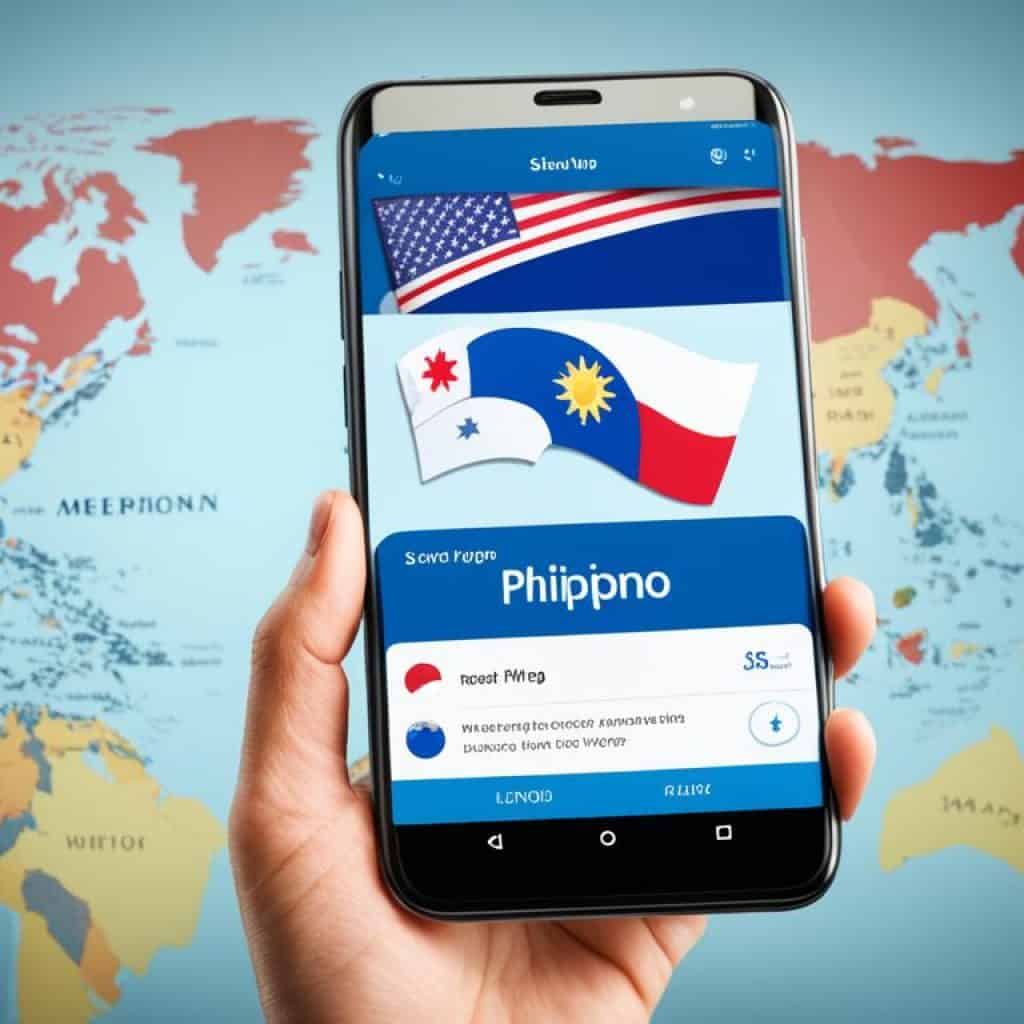Struggling to translate Filipino to English? You need a reliable tool to overcome the language barrier. Let’s explore top resources and methods. These will make translating Filipino to English easy. Whether it’s words, sentences, or paragraphs, we’ve got your back. Dive into fluent cross-language communication with us!
Key Takeaways:
- Online converters and dictionaries are available to assist with Filipino to English translation.
- Understanding special characters in the Filipino writing system is crucial for accurate translation.
- Translation apps can be a convenient way to translate Filipino to English on the go.
- Consider data safety and privacy when using translation apps.
- Read user reviews to choose the best translation app for your needs.
Special Characters in Filipino Writing Systems
The Filipino writing system is unique. It includes special characters and alphabets. One important alphabet is the Baybayin script. It was used before colonization by early Filipinos. The Baybayin alphabet has vowels, dependent vowels, and consonants.
The Latin alphabet is also key in writing Tagalog. It has uppercase and lowercase letters. These are vital for correct Filipino to English translation.
Knowing these characters and alphabets is essential. It helps anyone wanting to understand Filipino writing better. It also improves translation accuracy and appreciation of Filipino culture.
Baybayin Alphabet
The Baybayin alphabet is ancient and important in Filipino history. It has 17 basic characters, including three vowels and 14 consonants. Vowels can stand alone or be diacritical marks. Consonants have syllable-initial and syllable-final forms. This alphabet shows the linguistic traditions of early Filipinos and their rich heritage.
Tagalog Alphabet in Latin Script
The Baybayin alphabet is less used today. Now, the Latin alphabet is the main script for Tagalog. It has the English alphabet’s letters plus a few extra ones. These extra letters help in representing specific Tagalog sounds for correct pronunciation.
Understanding the Tagalog alphabet in Latin script is key for good communication and translation. It is the base for learning the language and understanding texts.
| Letter | Pronunciation | Example |
|---|---|---|
| A | ah | ama (father) |
| B | buh | bahay (house) |
| K | kuh | kamay (hand) |
| L | luh | lapis (pencil) |
| O | oh | oras (time) |
Learning the Tagalog alphabet in Latin script is crucial for fluency. It helps people read and write Tagalog well.
About Filipino to English Translation Apps
Looking to translate Filipino to English quickly? Filipino to English translation apps are your answer. These apps make it easy to switch between languages. They work as dictionaries and offer many features to improve your translations.
These apps are user-friendly. They’re simple to use for anyone – students, tourists, or travelers. This makes language learning and communication better.
Features like instant search and clipboard translation make translations fast. Need to understand a word or a whole paragraph? These apps can help.
They offer accurate translations with their extensive dictionaries. You get clear communication. Pronunciation guides and example sentences help too. This way, you understand words better in different situations.
Below, see a chart of the top Filipino to English translation apps:
| App Name | Key Features |
|---|---|
| Filipino-English Translator | An extensive database of words and phrases for accurate translations. Includes audio pronunciations and example sentences. |
| Translate Filipino to English | Instant translations with offline functionality. Offers voice input for hands-free translation. |
| Tagalog English Translator | Simple and user-friendly interface. Provides translations for various contexts, including travel, business, and everyday conversations. |
| Filipino English Dictionary | Extensive vocabulary with synonyms and antonyms. Allows for bookmarking and saving favorite translations. |
These are just a few examples of many available Filipino to English translation apps. Explore them to find the best one for your language journey.

If you’re learning Filipino, traveling in the Philippines, or improving your language skills, these apps are great. Download one today and explore new linguistic possibilities!
Data Safety and Privacy in Translation Apps
When using translation apps, it’s key to focus on data safety and privacy. Apps differ in how they handle your data. This varies by region and how old you are. Knowing these practices helps protect your personal info.
Some apps may gather data such as your location, app usage, and device ID. While needed for the app to work, it’s key to know how your data is used and shared.
For keeping your information safe, choose apps that use data encryption. This keeps your data safe from people who shouldn’t see it, as it travels to the app’s servers.
But remember, once your data is with the app, deleting it completely might not be possible. So, be careful about which apps you let have your personal info.
Putting your data and privacy first is crucial with translation apps. By knowing how apps handle privacy and ensuring they encrypt data, you can feel confident your info is safe.
User Reviews of Filipino to English Translation Apps
User reviews are key when picking a Filipino to English translation app. They give insights into how well the apps work. Users share their experiences, shedding light on the app’s accuracy and functionality.
Many find these apps quite useful for daily translations and learning the language. Their easy-to-use design and fast translations make talking between Filipino and English easy. They’re great for students, tourists, and travelers facing a new language.
“I’ve been using a Filipino to English translation app for a while now, and it has been a game-changer. I use it for translating conversations, menu items, and signs while traveling in the Philippines. It hasn’t let me down so far!” – Maria Torres
However, some users run into issues with certain words or phrases. The translation accuracy might vary based on your language skills and needs. It’s wise to look at user reviews to spot any possible limits or challenges.
Finding the best app depends on what you need it to do. Look for features like text-to-speech, offline options, and cultural insights. Knowing what you need will aid in choosing wisely.
“I found this one translation app to be accurate overall, but it struggled with regional dialects and slang. It’s great for basic translations, but for more complex language nuances, it may not be the best option.” – John Ramirez
Keep in mind, reviews are personal and can differ. Reading a variety helps you get a sense of what most people think. This way, you make a smarter choice.
Your main aim is to get an app that meets your needs and gives accurate Filipino to English translations.
The Benefits of Tagalog to English Translation Services
Tagalog to English translation services give a lot of benefits. They are key for **accurate translation services** and **culturally relevant translations**. These services help connect English-speakers and Tagalog-speakers, making sure we can talk and understand each other well in different situations.
These services are crucial for **business**, **education**, or just talking to each other. They make sure translations are grammatically correct. This is vital for translating important papers, contracts, and other key documents accurately.
Using **professional translation services** helps break down language barriers. This allows for clear communication between different languages. These services ensure translations capture the real meaning, cultural hints, and context of the Tagalog language.
“Tagalog to English translation services are valuable not only in delivering accurate translations but also in preserving the integrity and authenticity of the source material.”
Professional translators know both the language and the culture well. They provide translations that are true to the original while considering cultural differences. This makes sure the translation is not just correct in language but also fits culturally with the audience.
These services also mean you get **quality assurance**. Experienced translators check and fix translations to meet high standards of accuracy. This careful work means the translations are clear, mistake-free, and ready to use.
These services also mean your information stays safe and private. Translation agencies follow strict privacy rules. They keep your sensitive information secure, giving you peace of mind.
Experts in Tagalog, cultural details, and how to translate them are what make these services so useful. They’re necessary for anyone who needs correct, culturally aware translations, for personal or work reasons.
To learn more about translating Tagalog to English and its challenges, see the next section.
The Challenges of Translating Tagalog to English
The Challenges of Translating Tagalog to English
Translating Tagalog to English is uniquely challenging. Tagalog uses affixes, which are bits added to words to change their meaning. Finding equivalent words in English can be hard.
The affixes give Tagalog words special details and nuance. These might not have direct English equivalents. Translators must work carefully to capture the true meaning.
Tagalog’s use of adjectives adds to the challenge. These words add flexibility and detail to the language. Yet, in English, it’s often harder to express the same ideas without using more words or phrases.
Consideration of the Tagalog language’s cultural importance is also essential. It’s a key part of the Philippines’ heritage and the basis of Filipino. While translating, keeping Tagalog’s unique aspects alive is as crucial as making the text clear in English.
The Importance and Use of Tagalog in the Philippines
Tagalog is the cornerstone of the Filipino language, vital in the Philippines. It’s the nation’s language, spoken by millions across the globe. It connects with other local tongues, like Cebuano and Ilocano, weaving a rich language mosaic.
Its value goes beyond words. Tagalog is key for expression and creativity. Many Filipino authors use it to share thoughts and feelings. This tradition enriches the nation’s culture and boosts speaker pride.
Despite the influence of English and Spanish, efforts to keep Tagalog strong are in place. The goal is to keep it alive in Philippine heritage. Celebrating Tagalog shows the country’s love for its roots and diverse languages.

The Influence of Tagalog on Philippine Society
Tagalog’s impact stretches beyond mere conversation. It shapes education, media, and governance in the Philippines. As the education language, it spreads knowledge and unites the nation.
In media, Tagalog is key. A lot of TV, movies, and music are in Tagalog. This not only wins local hearts but also raises global cultural awareness.
Using Tagalog in government makes governance clear and inclusive. It ensures everyone is understood, valuing the country’s language diversity.
Tagalog as a Symbol of Cultural Identity
For Filipinos, Tagalog is a cultural beacon. It brings people with different backgrounds together. Tagalog helps maintain a connection to heritage and fosters national pride.
It’s more than a language. Tagalog carries history, values, and traditions. It’s key in keeping the culture alive and uniting the nation.
The Future of Tagalog
Tagalog’s future is bright, with ongoing support and recognition. As the Philippines celebrates its diverse culture, Tagalog remains central. It helps in understanding and national conversations.
The digital era offers Tagalog new growth paths. Social media and online content let speakers express and connect globally. This helps share the Filipino voice wider.
To sum up, Tagalog’s role in the Philippines is massive. It’s at the heart of Filipino culture and society. By nurturing Tagalog, the nation honors and passes on a precious heritage to future generations.
The Role of English to Tagalog Translation in a Globalized World
The business and communication world is growing closer due to globalization. This has led to a high demand for English to Tagalog translation services. They are crucial in helping English speakers understand the Tagalog-speaking community. These translations are important for both personal and professional uses. They make sure communication is clear in various situations.
These translation services are especially important for Filipinos living and working abroad. They may not be fluent in English. These services help them talk effectively with English speakers. This helps them overcome language challenges. With accurate translations, global communication improves. This builds stronger bonds in a fast-changing world.
One key benefit of these translations is overcoming language barriers. In business, education, or daily talk, language can be a big hurdle. English to Tagalog translators help people and groups cross this barrier. They let them connect with various audiences and markets. This way, translation services grow global communication and cultural exchanges.
In our multilingual world, being able to translate correctly is vital. Language differences can cause misunderstandings. An English to Tagalog translator makes sure the original message and cultural nuances are kept. This bridges language gaps. It ensures successful talks across different countries.
Translating from English to Tagalog is not just about changing words. It requires understanding the culture and its subtleties. Translators need to think about idioms, everyday language, and cultural references. This ensures translations are accurate and full. It helps share ideas and information worldwide.
For those wanting to connect with the Tagalog-speaking community, translation services are key. They are needed for marketing, legal papers, or website localization. Good translations help build connections and productive relationships. By choosing professional translators, companies show they respect the target culture. They are committed to clear communication.
In summary, English to Tagalog translation is very important in today’s world. It ensures good communication between English speakers and Tagalog speakers. By closing the language gap, translation services open new possibilities. They encourage sharing between cultures. For success, investing in accurate and meaningful translations is essential.
Conclusion
Various tools and services are available for translating between Filipino and English. Online platforms offer quick translations. Meanwhile, professional services guarantee both accuracy and respect for cultural nuances.
Tagalog’s preservation is vital, and translations from English play a key role in global dialogue. By using these tools, we can break down language barriers. This promotes clear and effective communication worldwide.
With services for Tagalog and Filipino translation, language challenges are easily overcome. Accurate translations by English services foster understanding. These solutions help us connect, whether for personal reasons or in business contexts.







Add comment